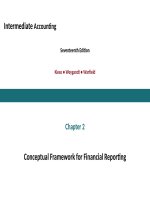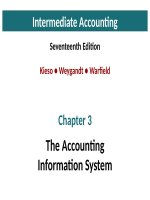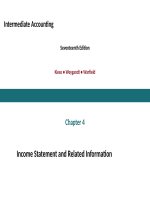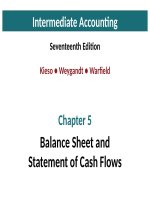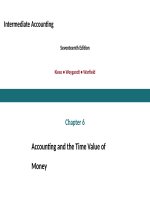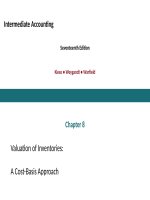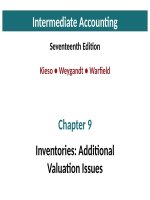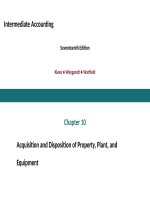Intermediate accounting 17e by kieso ch09
Bạn đang xem bản rút gọn của tài liệu. Xem và tải ngay bản đầy đủ của tài liệu tại đây (3.05 MB, 86 trang )
Intermediate Accounting
Seventeenth Edition
Kieso ● Weygandt ● Warfield
Chapter 9
Inventories: Additional
Valuation Issues
This slide deck contains animations. Please disable animations if
they cause issues with your device.
Learning Objectives
After studying this chapter, you should be able to:
1. Describe and apply the lower-of-cost-or-net realizable
value rule.
2. Describe and apply the lower-of-cost-or-market rule.
3. Identify other inventory valuation issues.
4. Determine ending inventory by applying the gross profit
method.
5. Determine ending inventory by applying the retail
inventory method.
6. Explain how to report and analyze inventory.
Copyright ©2019 John Wiley & Sons, Inc.
2
Preview of Chapter 9
Inventories: Additional Valuation Issues
Lower-of-Cost-or-Net Realizable Value
• Definition
• Illustration
• Methods of applying
• Recording
• Use of allowance
• Multiple periods
Copyright ©2019 John Wiley & Sons, Inc.
3
Preview of Chapter 9
Lower-of-Cost-or-Market
• How LCM works
• Methods
• Evaluation of LCNRV and LCM rules
Other Valuation Approaches
• Net realizable value
• Relative sales value
• Purchase commitments
Copyright ©2019 John Wiley & Sons, Inc.
4
Preview of Chapter 9
Gross Profit Method
• Gross profit percentage
• Evaluation of method
Retail Inventory Method
• Concepts
• Conventional method
• Special items
• Evaluation of method
Copyright ©2019 John Wiley & Sons, Inc.
5
Preview of Chapter 9
Presentation and Analysis
• Presentation
• Analysis
Copyright ©2019 John Wiley & Sons, Inc.
6
Learning Objective 1
Describe and Apply the Lower-of-Costor-Net Realizable Value Rule
LO 1
Copyright ©2019 John Wiley & Sons, Inc.
7
Lower-of-Cost-or-Net Realizable Value
A company abandons the historical cost principle when
the future utility (revenue-producing ability) of the asset
drops below its original cost.
Definition of Net Realizable Value
• Estimated selling price in the ordinary course of
business, less reasonably predictable costs of
completion, disposal, and transportation
LO 1
Copyright ©2019 John Wiley & Sons, Inc.
8
Definition of Net Realizable Value
Illustration
Assume that Mander Corp. has unfinished inventory with a
cost of $950, a sales value of $1,000, estimated cost of
completion of $50, and estimated selling costs of $200.
Mander’s net realizable value is computed as follows.
LO 1
Copyright ©2019 John Wiley & Sons, Inc.
9
Definition of Net Realizable Value
LCNRV Disclosures
• Mander reports inventory at $750
• In its income statement, Mander reports a Loss Due
to Decline of Inventory to N R V of $200 ($950 −
$750)
Kesa Electricals
Inventories are stated at the lower-of-cost-or-net realizable value.
Cost is determined using the weighted average method. Net realisable
value represents the estimated selling price in the ordinary course of
business, less applicable variable selling expenses.
LO 1
Copyright ©2019 John Wiley & Sons, Inc.
10
Illustration of LCNRV
Determining Final Inventory Value – Regner Foods
LO 1
Copyright ©2019 John Wiley & Sons, Inc.
11
Method of Applying LCNRV
Alternative Applications of LCNRV
Companies usually price inventory on an item-by-item basis.
LO 1
Copyright ©2019 John Wiley & Sons, Inc.
12
Recording NRV Instead of Cost
The following inventory data is for Ricardo Company.
Ending inventory (cost)
Ending inventory (at NRV)
Adjustment
$ 82,000
70,000
$ 12,000
Loss
Method
Loss Due to Decline in Inventory
Inventory
12,000
COGS
Method
Cost of Goods Sold
Inventory
12,000
LO 1
Copyright ©2019 John Wiley & Sons, Inc.
12,000
12,000
13
Recording NRV Instead of Cost
Use of an Allowance
Instead of crediting the Inventory account for market
adjustments, companies generally use an allowance account,
often referred to as Allowance to Reduce Inventory to NRV.
Loss Due to Decline of Inventory to NRV
Allowance to Reduce Inventory to NRV
12,000
12,000
Presentation of Inventory Using an Allowance Account
Inventory (at cost)
Allowance to reduce inventory to NRV
Inventory (at NRV)
LO 1
Copyright ©2019 John Wiley & Sons, Inc.
$ 82,000
(12,000)
$ 70,000
14
Recording NRV Instead of Cost
Balance Sheet
Loss
Method
Current assets:
Cash
Accounts receivable
Inventory
Less: allowance to market
Prepaids
Total current assets
LO 1
COGS
Method
$ 100,000 $ 100,000
350,000
350,000
770,000
758,000
(12,000)
0
20,000
20,000
$1,228,000 $1,228,000
Copyright ©2019 John Wiley & Sons, Inc.
15
Recording NRV Instead of Cost
Income Statement
LO 1
Copyright ©2019 John Wiley & Sons, Inc.
16
Use of an Allowance—Multiple Periods
In general, accountants adjust the allowance account
balance at the next year-end to agree with the
discrepancy between cost and the LCNRV at that balance
sheet date.
Date
Dec. 31, 2016
Dec. 31, 2017
Dec. 31, 2018
Dec. 31, 2019
LO 1
Inventory Inventory at
at Cost
NRV
$188,000
$176,000
194,000
187,000
173,000
174,000
182,000
180,000
Amount
Adjustment
Required in of Valuation
Valuation
Account
Effect on Net
Account
Balance
Income
$12,000 $12,000 inc.
Decrease
7,000
5,000 dec.
Increase
0
7,000 dec.
Increase
2,000
2,000 inc.
Decrease
Copyright ©2019 John Wiley & Sons, Inc.
17
Learning Objective 2
Describe and Apply the Lower-of Costor-Market Rule
LO 2
Copyright ©2019 John Wiley & Sons, Inc.
18
Lower-of-Cost-or-Market (1 of 6)
The use of the lower-of-cost-or-net realizable value method
works well to measure the decline in value of a company’s
inventory for most companies.
FASB granted an exception to the LCNRV approach for
companies that use the LIFO or retail inventory methods.
• Rather than comparing cost to net realizable value
companies compare a “designated market value” of
inventory to cost
• Approach is commonly referred to as lower-of-cost-ormarket (LCM)
LO 2
Copyright ©2019 John Wiley & Sons, Inc.
19
Lower-of-Cost-or-Market
Two Limitations
This approach begins with replacement cost, then applies two
additional limitations to value ending inventory.
• Net realizable value (ceiling)
• Net realizable value less a normal profit margin (floor)
LO 2
Copyright ©2019 John Wiley & Sons, Inc.
20
Lower-of-Cost-or-Market
Net Realizable Value (NRV)
NRV is the estimated selling price in the ordinary course of
business, less reasonably predictable costs of completion and
disposal.
A company values inventory at the lower-of-cost-or-market,
with market limited to an amount that is not more than net
realizable value or less than net realizable value less a normal
profit margin.
LO 2
Copyright ©2019 John Wiley & Sons, Inc.
21
Lower-of-Cost-or-Market
Illustration
Assume that Parker Corp. has unfinished inventory with a
sales value of $1,000, estimated cost of completion and
disposal of $300, and a normal profit margin of 10 percent of
sales. Parker determines the following net realizable value.
Inventory—sales value
Less: Estimated cost of completion and disposal
Net realizable value
Less: Allowance for normal profit margin (10% of sales)
Net realizable value less a normal profit margin
LO 2
Copyright ©2019 John Wiley & Sons, Inc.
$ 1,000
300
700
100
$ 600
22
Lower-of-Cost-or-Market
Inventory Valuation
What is the rationale for the
Ceiling and Floor limitations?
LO 2
Copyright ©2019 John Wiley & Sons, Inc.
23
Lower-of-Cost-or-Market
Rationale
What is the rationale for the Ceiling and Floor
limitations?
• Ceiling – prevents overstatement of the value of
obsolete, damaged, or shopworn inventories
• Floor – deters understatement of inventory and
overstatement of loss in current period
LO 2
Copyright ©2019 John Wiley & Sons, Inc.
24
How Lower-of-Cost-or-Market Works
$65,000
Loss Due to Decline of Inventory to Market
Allowance to Reduce Inventory to Market
LO 2
Copyright ©2019 John Wiley & Sons, Inc.
65,000
65,000
25
